How Bluesky is offering new opportunities for universities
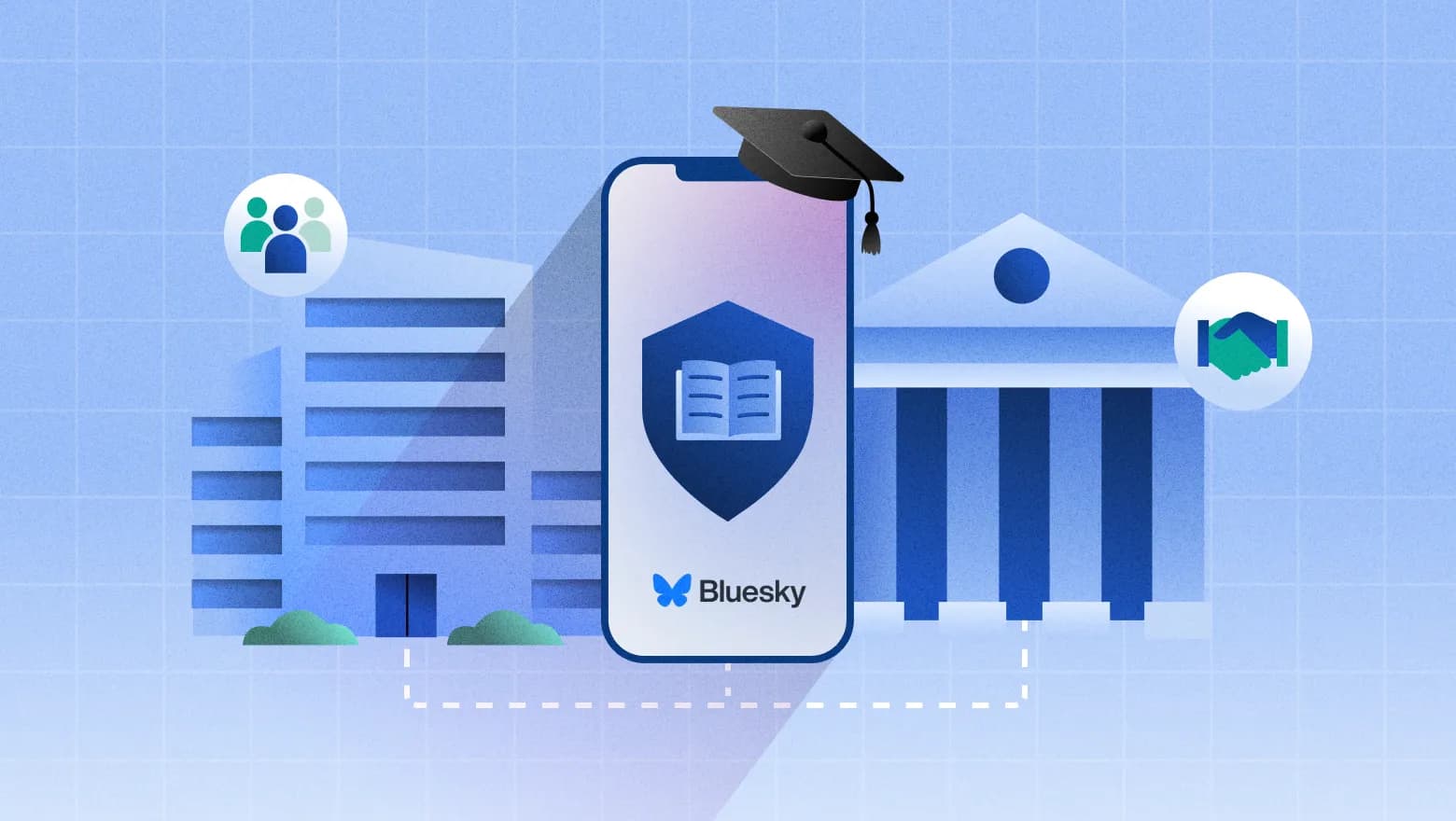
Table of Contents
Public conversation has always been an important part of university and college culture, with social media now serving as the “town square” to share ideas, experiences and research. While X (formerly Twitter), Instagram and Facebook are still popular in higher education social media strategy, a new platform is emerging as the choice for students and educators to connect. Bluesky is becoming a home base for researchers to share ideas, and universities, colleges and trade schools to build niche communities with students and staff.
Bluesky offers a micro-blogging structure similar to X with several key differences. Higher education professionals and students are exploring the platform as both a place to share and stay up to date. And they’re not alone: According to a Q2 2025 Sprout Social Pulse Survey, 48% of global social media users plan to spend more time on emerging networks like Bluesky.
Bluesky attracts a younger demographic, making it a natural fit for universities trying to reach students entering higher education.
In this article, we’ll dive into using Bluesky for higher education communities and share insights from colleges already on the platform.
Why universities are moving to Bluesky
Bluesky is a decentralized social media platform. This category of social networks differs from legacy networks like Instagram and X in that they aren’t owned by a single entity and or confined to a centralized server.
Transparent algorithms and user control
Since Bluesky is decentralized, it doesn’t use a top-down algorithm that dictates what content is suggested to users based on a single global server. Instead, users have more control over their individual algorithm, creating an evolving feed curated just for them. They also appreciate network transparency and the niche communities that thrive there.
More direct connection to academics, students and research communities
The user base on Bluesky also skews younger, aligning with a significant portion of universities’ incoming student groups.
According to Danielle Gabriel, Director of Marketing at Portland Community College (PCC), this is a crucial factor for universities investing in outreach, and a key driver behind the creation of PCC’s Bluesky presence. “We launched PCC’s official account to stay ahead of emerging communication channels and meet our audiences where they are migrating,” she notes.
Autumn Benitez, Social Media Specialist at Sprout Social, agrees. She says Bluesky could be a tool for relationship building for colleges.
“Bluesky’s transparent platform is a game-changer for universities looking to actually cut through the noise and build genuine connections with students and researchers,” she says. “Its focus on user control and real-time conversations let higher ed institutions engage authentically.”
No ad clutter, leading to credibility of academic content
The app is also ad free. This means significantly less clutter, making it easier to reach students and research communities. Plus, no ad-spend needed..
“Bluesky isn’t just about ditching ads. —It gives academic communities the power to steer their own conversations and build tight-knit networks around what really matters,” Benitez says. “It’s a fresh space for real knowledge sharing and collaboration,” she adds.”
Vibrant, topic-focused feeds
Bluesky also offers vibrant, topic-focused feeds that are useful for research and intellectual exchange. A range of topics—from agriculture to philosophy—can be found. And universities can curate “Starter Packs” to help users find and follow accounts within relevant spheres.
For institutions like Portland Community College, this is relevant in more ways than one, including tapping into social media culture. Gabriel sees Bluesky as a chance to tap into social media culture in a new way. “It’s an interesting opportunity to experiment in a space that’s still shaping its culture, voice and norms,” she says. “It also allows us to reinforce PCC’s identity as a forward-thinking, innovative institution that embraces new ways to connect with our community.”
It’s important to remember though, that Bluesky is still an emerging platform, and universities may only find near-term value if their audience is already there.
“It’s still early days, so smart experimentation is key to unlocking Bluesky’s full potential,” Benitez explains.
Universities on Bluesky (and their approach)
To better understand what that potential includes, let’s review how a few schools are currently using Bluesky.
University of Oxford
Oxford has a thriving Bluesky presence, with over 14,000 followers. A portion of their content is focused on updates about the university and students. Most of their posts feature internal and external articles about the research happening at the university. From nutrition to political science, Oxford’s feed offers an inside look at the latest studies and findings.
Many of Oxford’s individual colleges have their own Bluesky accounts, which are often tagged in posts. This creates an opportunity to share commentary from various expert voices at the university on current topics. These pieces often tie to research being conducted as well.
The City University of New York (CUNY)
CUNY’s Bluesky feed functions as a daily update of news from the school, individual colleges and education-related topics in New York City at large. Posts include updates about enrollment numbers at the university, various grants and funding and new programs/certificates being offered by various departments. The account also spotlights current students and their achievements in competitions and research.
Students can also find useful information on arts and entertainment happenings on campus and upcoming sporting events. The overall feed is for students and academics alike to get quick access to CUNY news and opportunities and explore what the school has to offer.
Portland Community College (PCC)
PCC’s Bluesky feed showcases updates about the college itself as well as events across the multiple campuses the school has. There’s a focus on cultural events, highlighting that smaller colleges like PCC are just as community and diversity focused as large universities. PCC also shares content about their students, many of whom fit the “non-traditional” category and attend the college’s more trade-centric programs.
PCC’s Bluesky is link heavy, giving it an RSS feed-style feel. Students, staff and community members can easily scroll through to find stories they can explore more in-depth with a click.
Best practices for universities on Bluesky
If you’re ready to spread your wings and explore what Bluesky has to offer, it’s a good idea to consider some best practices to get the most out of the platform. Here are some approaches to get you started.
Claim your brand account
First, you’ll set up your university’s account. The basic format for Bluesky handles is @NAME.bsky.social, but there are ways to customize further. It’s possible to use domain names you own as a handle, (@NAME.university.edu for example), and higher education institutions can go through a verification process to get a blue check mark.
Once you have your handle, add your logo, header image, descriptive bio and important links. These can be fairly similar to your bios on other social media platforms.
Decide on your department’s strategy
The different departments across your institution, from colleges to newspapers to student organizations, all have great information to share. As you set up your initial account, determine the strategy you want to employ for individual accounts. Keeping everything centralized on one account can streamline things and simplify maintaining your brand voice. However, allowing departments to have individual accounts can expand your audience, build highly-engaged niche communities and take some of the pressure off your university’s social team. There’s no wrong answer here, so design a strategy that fits your school best.
A social media management platform like Sprout Social is useful here if you choose to go the multi-account route. Sprout helps streamline all handles into one location, and you can add in approval workflows to ensure content across the board is aligned. This enables individual departments to share unique content while keeping your brand voice consistent.
Curate Starter Packs
Starter Packs are lists of relevant accounts and resources that Bluesky users can follow with a single click. For universities allowing individual department accounts, Starter Packs are an excellent way to collect all of those feeds in one place for interested users to follow. You could also create Starter Packs of university staff to follow, sports teams, student groups and to support a niche marketing approach.
Additionally, individual Bluesky users may create Starter Packs related to education that may include your university account.
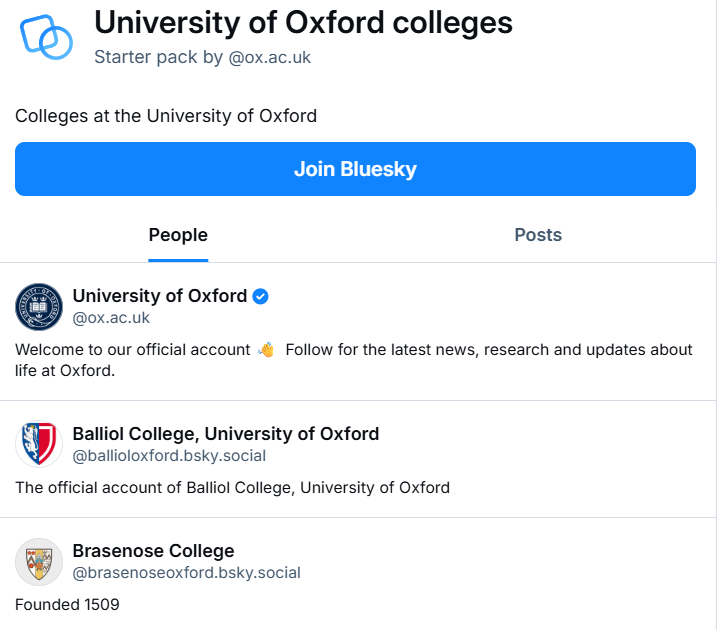
Design a content strategy
Consider your priorities for Bluesky to discern what your content approach should be. What are your goals and how does it align with your broader social media marketing strategy? Are there niche social media audiences you can specifically target on Bluesky? You can use your feed as an update/news tool, a thought leadership vehicle or a mix of both. You can share links, text posts, images and videos of up to 60 seconds, and much of your content from other social channels can likely be used here as well.
Sprout Social helps you take your Bluesky strategy further with publishing and scheduling for the app. Via Sprout, you can publish all types of content on Bluesky (including alt text for images) and tap Generate by AI Assist to help you iterate content ideas.
Build community
Since there are no ads on Bluesky, your strategy will focus on organic engagement and growth. Let your students and alumni know you’re on Bluesky via your website, emails, orientation sessions, etc. to start building your audience. Engage with followers as they find you, responding to comments and resharing content they tag your school in.
You can nurture community through curated Starter Packs that connect students to resources, and foster discussion on research topics.
Gabriel says PCC sees this as a key benefit of Bluesky. “Long-term, we see BlueSky as a place to cultivate community-first engagement rather than one-way broadcasting,” she notes.
Develop custom feeds
Without an overarching algorithm, Bluesky users can create custom feeds on whatever topics they wish. These can then be followed by other users who want to see content on a specific topic or niche discussion. Your university can create these for the school itself, research topics or student interests. Having custom feeds available can enhance the student experience on Bluesky and create more relevant community discussions for them to participate in.
Listen for feedback and insights
Bluesky uses a chronological timeline—something many other social media networks have moved away from. It’s easier for you to see recent posts in custom feeds and the content of those you follow on Bluesky, making it a useful tool for social listening.
For example, if you have a custom feed for your university and are interested in how new students are responding to orientation and the school year’s kick off, you’ll be able to see students sharing their experience on Bluesky in real time.
As you track community discussions, you can jump in and contribute as the official university voice where it makes sense. You can also notice patterns in feedback and see potential issues coming down the line.
Monitor performance and growth
Tracking how your content does is an exciting part of social media in the education space, as each engagement represents a real student or alumni. Currently, Bluesky doesn’t offer built-in analytics dashboards, though you can manually track metrics such as likes and reposts.
However, Sprout Social connects with Bluesky, which enables you to track KPIs alongside your other networks automatically, saving you manual effort. Sprout also monitors engagement metrics and provides you with post-performance reports to support your Bluesky strategy and overall social media presence.
Embracing Bluesky for education
Experimenting with emerging social platforms like Bluesky can help universities and colleges stay competitive and connect with audiences in new ways. There’s potential for student and alumni communities as well as research dissemination and discussion on Bluesky, creating a new “town square” that can reach beyond campus walls.
For a look at how schools are evolving their social media approach across platforms, check out our social media benchmarks report for education.

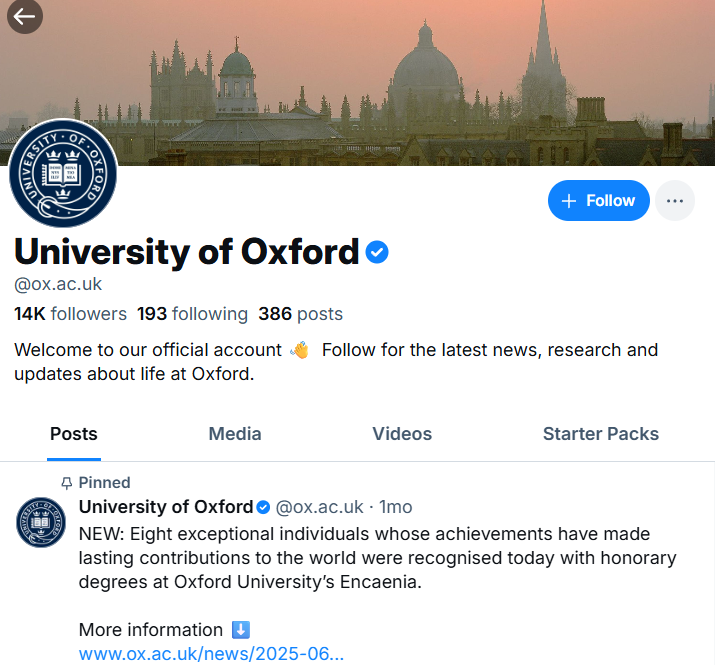
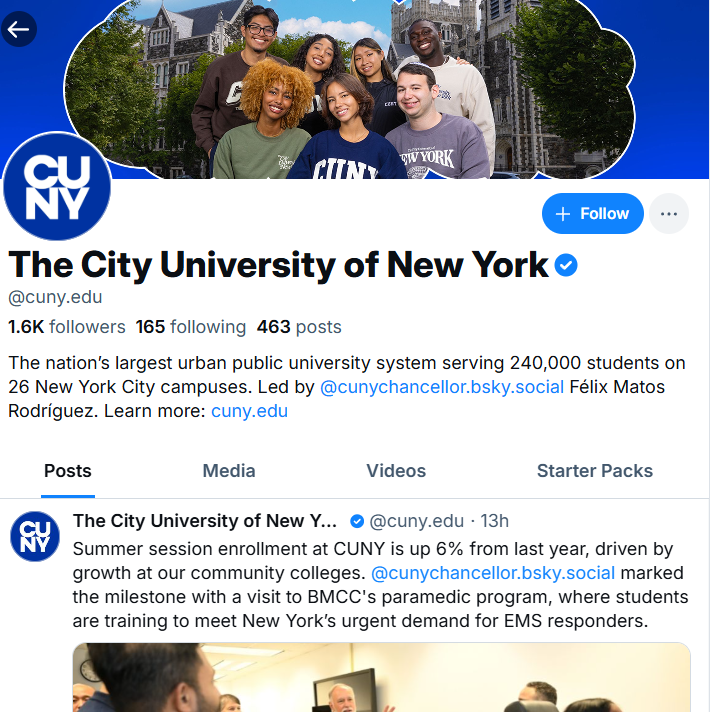


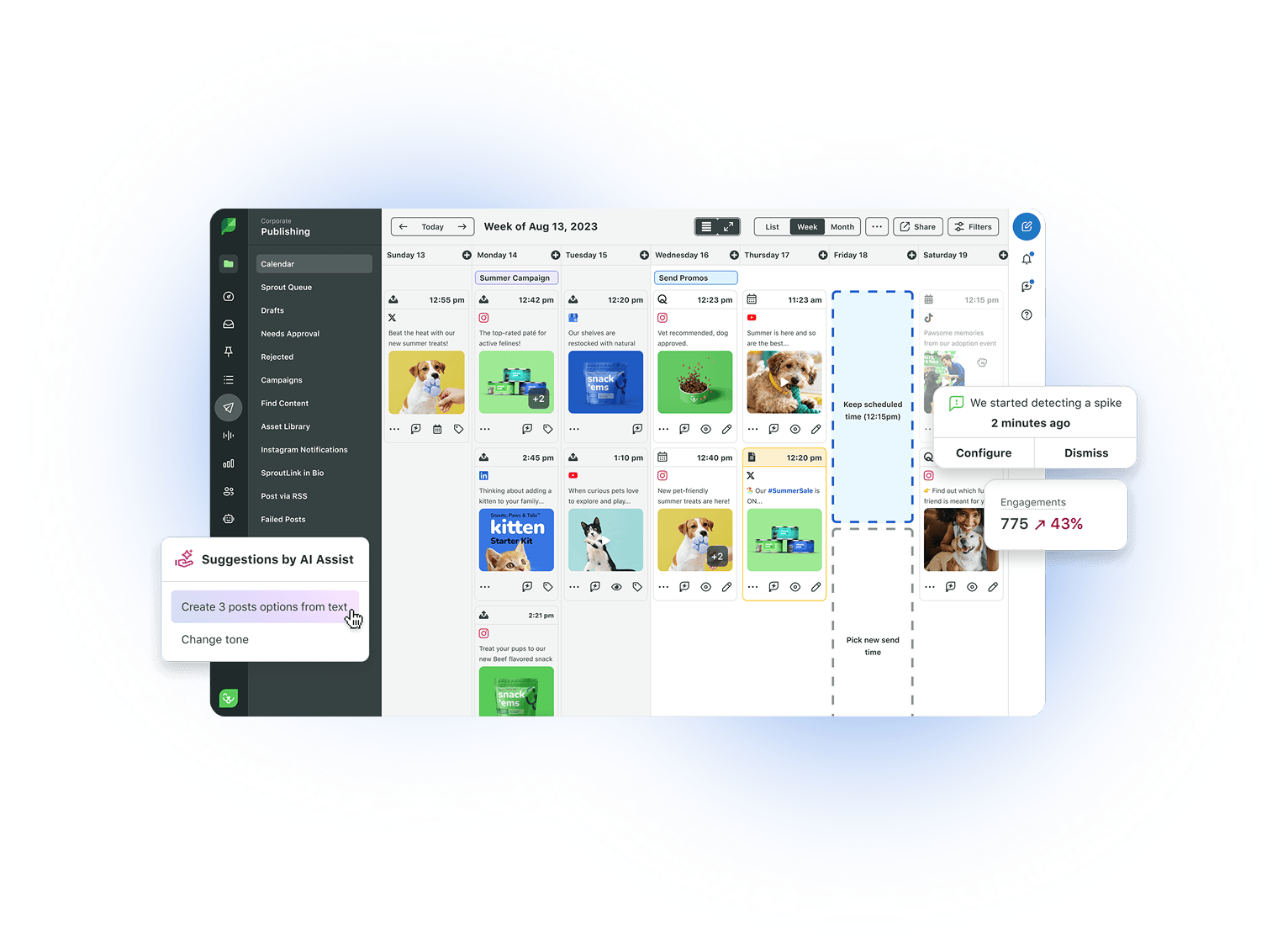
Share